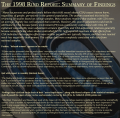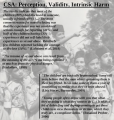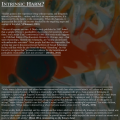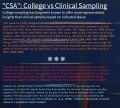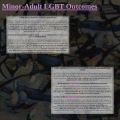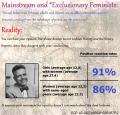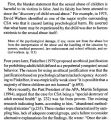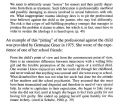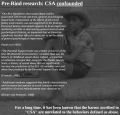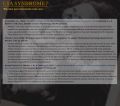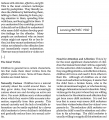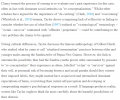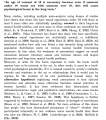One of our staff members is contributing considerably to a News Archiving service at Mu. Any well educated (Masters, PhD or above) users who wish to make comments on news sites, please contact Jim Burton directly rather than using this list, and we can work on maximising view count.
Research: Age of Innocence
 | ||||||||||||
| Part of NewgonWiki's research project | ||||||||||||
|---|---|---|---|---|---|---|---|---|---|---|---|---|
|
| ||||||||||||
| ||||||||||||
|
| ||||||||||||
| Template: Research - This template |
- Most literature used in this anthology fails to sample and/or define CSA in a way that can be generalized to the wider population, instead focusing exclusively on coercive/unwanted acts. The article uses these types of study, because they are the only literature showing significant harms associated with CSA. Other (representative) studies include all acts legally defined as CSA, and show no significant relationship between said "CSA" and psychological dysfunction. See Prevalence of Harm and Negative Outcomes.
It is widely assumed that when forced or unwanted (a minority of) sexual contact does take place with adults, younger minors are especially vulnerable to harm. This is said to manifest itself in the form of multiple psychological impairments in later life. Much like the idea that CSA "syndrome" takes on a certain observable form, these ideas are not supported by quantitative evidence. It instead appears that the perception of having been abused is associated with comparable negative psychological outcomes, regardless of the age at which the perceived abuse took place. Causation is nevertheless very hard to prove.
Unrepresentatively sampled and/or coercive CSA studies
Studies which focus on a) unrepresentative clinical samples rather than the wider population, and/or b) narrow definitions of CSA which focus on coercion or unwillingness, have only very occasionally shown an association between age of onset and severity of symptoms. However, said relationship is not always in the expected direction according to traumatological norms. Where this expected relationship is observed, this might be because of self-perception, as sexual contacts before puberty - regardless of coercion, are rarer and considered taboo. It might also be in part due to the higher prevalence of forced incestuous contacts at a younger age of first onset (incest is usually associated with more negative outcomes). Such studies often fail to control for confounding variables, or account for pre-existing genetic and/or socialized character traits in victims, which may put them at risk of both early victimization and later development of psychological problems. The role of multiple forms of victimization is also underexplored in relation to age; see our section on poly-victimization. A sampling of this literature follows:
- Bulik, C. M., Prescott, C. A., & Kendler, K. S. (2001). Features of childhood sexual abuse and the development of psychiatric and substance use disorders. British Journal of Psychiatry, 179(05), 444–449.
- "Age at the time of first CSA ranged from under 5 to 15 years, with the majority of individuals being between 12-15 years old. [...] We observed no increased risk of later psychopathology related to the age at which an individual was first abused, the number of, or the gender of the perpetrators." [Tables in the paper corroborate this claim - Ed]
- Maker, A. H., Kemmelmeier, M., & Peterson, C. (2001). Child sexual abuse, peer sexual abuse, and sexual assault in adulthood: A multi-risk model of revictimization. Journal of Traumatic Stress, 14(2), 351–368.
- "With regard to the consequences of pre-16 years and post-16 years sexual victimization, we found that that the latter was associated with lower levels of functioning on many of the mental health and behavioral outcomes. By contrast, pre-16 years sexual trauma (CSA or PSA) was only related to some maladaptive behavioral and psychological consequences. The pattern of findings is consistent with the assumption that more recent trauma has a greater impact on psychosocial functioning than more distal child abuse. This does not mean that CSA and PSA are less detrimental, but perhaps that women have had a longer time to cope with the effects of CSA in comparison to that of ASA (cf. Rind et al., 1998)."
- Li, D., Chu, C. M., & Lai, V. (2020). A Developmental Perspective on the Relationship between Child Sexual Abuse and Depression: A Systematic and Meta‐Analytic Review. Child Abuse Review, 29(1), 27–47.
- "The second meta-analysis with 3340 CSA victims showed inconsistent findings when different study characteristics were taken into consideration. Earlier CSA onset was found to be significantly related to the risk for depression with a small-to-moderate effect size in studies using female, adult or clinical/community samples and where CSA onset was measured as a continuous age variable. In contrast, this relationship was not found in studies mixed-gender, younger age or student samples and where CSA onset was measured as a categorical developmental stage. [...] However, it was also noted that the non-significant differences between childhood-onset and adolescent-onset CSA as found in this study were not consistent with these theories. These inconsistent findings caution against the use of a simple linear model between the age at CSA onset and depression. For example, a V-shape relationship was found between the two constructs where the odds of depression were higher for CSA onset at early childhood and adolescence, whereas CSA onset at prepubertal (i.e. 9 and 10 years) was not related to higher odds of depression when compared to the non CSA group (Dunn et al., 2013). Based on these findings, using a simple categorical classification of childhood and adolescence to study the age effects of CSA is not recommended. [...] Confounding variables are a more concerning bias. Our biggest concerns are the disadvantaged family background and the (co-)occurrence of other traumatic experiences, such as other abuse types, low socio-economic status and parental mental health problems (e.g. Bernet and Stein, 1999; Moskvina et al., 2007; Tunnard et al., 2014). On account of the higher likelihood of multiple forms of maltreatment in these households, some of the variance may be attributed to these confounding factors. As a familial disorder, depression in parents could be a risk factor for both CSA and depression in children. As such, the unique contribution of CSA to the onset of depression was not clear from the current analyses."
- Ulibarri, M. D., Ulloa, E. C., & Salazar, M. (2015). Associations between Mental Health, Substance Use, and Sexual Abuse Experiences among Latinas. Journal of Child Sexual Abuse, 24(1), 35–54.
- "Whereas some research focuses primarily on childhood sexual abuse and others focus on adult sexual abuse victimization, the results of the current study suggest that both may have negative consequences for Latinas regardless of how old they were when they were first sexually abused."
- Paolucci, E. O., Genuis, M. L., & Violato, C. (2001). A Meta-Analysis of the Published Research on the Effects of Child Sexual Abuse. The Journal of Psychology, 135(1), 17–36.
- "For the present meta-analysis, we have defined CSA as any unwanted sexual contact (ranging from genital touching and fondling to penetration) during the period in which the victim is considered a child by legal definition and the perpetrator is in a position of relative power vis 2 vis the victim [...] gender, socioeconomic status (SES), type of abuse, age when abused, relationship to perpetrator, and number of incidents of abuse were not found to mediate the effect of CSA on these outcomes. [...] These results do not corroborate the findings of other studies that have found an increased risk for the development of negative outcomes depending on the type of sexual abuse experienced, the child’s age, repetition of abuse, and familiarity with the perpetrator."
- Friedrich, W. N., Urquiza, A. J., & Beilke, R. L. (1986). Behavior Problems in Sexually Abused Young Children. Journal of Pediatric Psychology, 11(1), 47–57.
- "Age was not significantly correlated with sexual problems. [...] However, there is greater ambiguity in the literature for the variable duration and age at onset. Although duration was significantly correlated with internalizing, externalizing, and sexual behavior, neither it nor age at onset contributed significant unique variance to the regression statements"
Most studies that sought to answer this question, found no association between the age of onset and intensity of later psycholological sequelae.[1] (see more in Research: Association or Causation and Outcomes and severity)
Studies which use Rind-type CSA definitions
It should be noted that the above studies (which nearly always insist on self-perceived abuse and/or use of force) are fundamentally different to the Rind/Daly type studies which canvass for all legally defined "CSA" regardless of force or perception of abuse, and meta-analyze such data. With the latter type of study, it may well be the case that younger "victims" of legally-defined CSA go on to perceive these events as more negative, however, concrete psychological outcomes are known to be no different to the general population. The reasons for this more negative self-perception may again be related to wider social factors such as the taboo on sex with prepubescent children, illegality selecting for deviance, opportunism and secrecy, higher frequency of incest and abuse of the underprivileged social position of smaller children. As a result of this, and the tendency of older minors to be more open to initiating a contact, coercive contacts are likely to be overrepresented in the younger age of onset group, throughout society at large.
The following studies did not insist upon force or use unrepresentative sampling (hence the now familiar and highly replicable absence of negative psychological adjustment in the CSA group as per Rind's study).
- Dana Larssi, Ortal Wasser and Dafna Tener. (2022). ‘Lover, Mentor, or Exploiter: Retrospective Perspectives of the Older Person Following Sexual Relationships with Adults During Adolescence’, in Archives of Sexual Behavior, 51:2, pp. 987-999.
- Abstract: "Sexual relationships between an adolescent and an older person are considered controversial and in many countries are conceptualized under the legal definition of statutory relationship/rape. Despite the consensus regarding their potential negative implications, little is known about how adolescents perceive and construct them. To address this lacuna, the current exploratory study examined how individuals who have experienced sexual relationships with an adult while growing up perceived the older person and the meaning they ascribed to the age gap (M age gap, 7.78 years; range, 2–18 years). A qualitative thematic methodology was incorporated in analyzing in-depth semi-structured interviews with 28 individuals (M age, 29.89 years) who had experienced sexual relationships with an (at least 2 years) older person during adolescence (M age, 14.78 years). Participants described five different perceptions of the older persons: romantic partner; sexual partner; authority figure; complex/unstable figure; and exploiter. Subsequent analysis, focusing on the role participants assigned to age when describing these different images of older persons, shed additional light on their subjective perceptions; namely, for each image, age had a particular meaning. This paper may contribute to the understanding of individuals’ experiences of sexual relationships with an older person by emphasizing the complexity of such relationships, as reflected in the participants’ construction of the older person’s image, potentially providing important information that can inform best practice for professionals working with this population. Findings highlight the need to address diversity and ambiguity rather than the uniform dichotomy that characterizes the legal framing of automatically constructing these relationships as statutory. Further implications for research, policy, and practice are discussed."
- Rind, B. (2020). First Sexual Intercourse in the Irish Study of Sexual Health and Relationships: Current Functioning in Relation to Age at Time of Experience and Partner Age. Archives of Sexual Behavior.
- "The vast majority of cases involved postpubertal heterosexual coitus. Overall, minors involved with adults were not significantly less well adjusted than adults involved with other adults on a majority of measures, effect size differences in adjustment were mostly small, and mean adjustment responses consistently indicated good rather than poor adjustment. "
- Rind, B., & Welter, M. (2013). Enjoyment and Emotionally Negative Reactions in Minor–Adult Versus Minor–Peer and Adult–Adult First Postpubescent Coitus: A Secondary Analysis of the Kinsey Data. Archives of Sexual Behavior, 43(2), 285–297.
- "For males, boys aged 14 and under with women had emotionally negative reasons in 15 % of the cases, which was not significantly different from any other category and was nearly the same nominally as men with peer-aged women (12 %). Likewise, girls aged 14 and under with men had emotionally negative reasons in 18 % of the cases, which was not significantly different from the other categories, in particular women with peer-aged men (16 %). Between-gender contrasts revealed only one significant difference: men with peer-aged women less often had emotionally negative reasons (12 %) than women with peer-aged men (16 %)"
- Briere, J., & Runtz, M. (1988). Symptomatology associated with childhood sexual victimization in a nonclinical adult sample. Child Abuse & Neglect, 12(1), 51–59.
- "Victim age at first abuse, presence of intercourse, and actual number of abuse incidents were not associated with either acute or chronic symptomatology" [Editor: While the sampling and definitions of CSA in this study appear to be representative, there was no attempt to eliminate confounds such as family environment. This is a common problem in such literature]
Excerpt Graphic Library
The EGL on Harm covers some adjacent topics, and we will produce a graphic reviewing this topic soon. Just right click/save and reproduce by uploading in short-form media to bypass character limits.
-
Basic Rind Paradox infographic
-
Summarized Rind findings
-
Rind and Tromovitch (2000) on Iatrogenic Harm
-
Research pointing to no intrinsic harm profiled in The Guardian
-
What victimologists say about youth perception + admissions of iatrogenic harm
-
Self-perception: Importance
-
Some reading on secondary harm and perception/situational variables
-
More secondary harms
-
Intrinsic vs secondary harm
-
Daly's 2021 repetition of Rind (1998), finds that self-perception is far more important that abuse status
-
Lahtinen Report: Most common reason for not reporting - event not serious enough
-
Bender. Sexologist's observations in 1969
-
College outcomes: Benefits of college samples
-
LGBT outcome/perception data (links to papers in this release)
-
Arreola 2009 - Psych outcomes for LGBT "CSA" identical to no sex
-
Simpler way of expressing Lesbian outcomes (ref to modern feminism)
-
Further distillation of Rind's Kinsey analysis
-
Finer analysis of Finnish Victimization Survey (Rind)
-
General reading on intrinsic harm
-
Oellerich on the self-fulfilling prophecy of iatrogenic harm
-
Oellerich comments further on iatrogenic harm
-
CSA harm was known to be confounded even before Rind
-
No "typical" CSA reaction or "syndrome"
-
Rind on methodological issues/limitations of victimology
-
The Lanning (1992) report - full of hysterical conjecture, nevertheless describes the "most common" forms of offender and victim in banal terms that are applicable to most relationships (in order to prepare investigators to pathologize banality)
-
Percy Foundation review of Chloe Taylor: "Foucault, Feminism, & Sex Crimes"
-
2022 debate response
-
Illinois state investigation finds a "pedophile" was his victims' "best friend"

